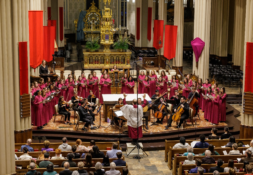Experiencing Christianity through classical art
Caravaggio’s “The Calling of St. Matthew” is the only painting that has ever moved me to tears. It was painted in 1600, but it depicts an event that happened to me.
In order to see the painting, I had to find the small side chapel in the church of San Luigi dei Francesi in Vatican City. Navigating the cobblestone streets, I found my way into the church and proceeded into the chapel, where I noticed a small box with a slot for a one euro coin which would turn on the lights to illuminate the painting. Classic. I pushed a coin into the box, amused at the Italian ability to profit from anything, and lights flooded the image. My eyes traveled across the painting, landing on the face of a bearded man pointing at himself, and my annoyance melted away as I realized that Caravaggio had captured the moment at which my life had changed.
The bearded man, St. Matthew, stares intently at the men on the right of the image. Following his gaze, I saw Jesus’ hand, which occupies a central place in the painting. Where had I seen this hand? Drawing from Michelangelo’s “The Creation of Adam,” Caravaggio depicts the hand of Jesus as a perfect replica of Adam’s hand—and yet, it comes from the same direction from which Michelangelo depicts God’s extended hand. In combining Michelangelo’s famous illustrations of God and man, Caravaggio masterfully reveals the power of the Incarnation.
Before Christ enters the world, as seen in Michalangelo’s “The Creation of Adam,” man lazily points his finger and his attention to God while God strains for man’s heart. The Incarnation changes everything—God becomes man, and he stands before St. Matthew and before me, and I cannot ignore his call. In front of this man who points at me, I have no choice: my finger must be turned back towards myself to ask the question, “Who, me?”
The encounter takes place in an unquestionably common setting. Caravaggio depicts the room as dark and dingy, and there is no mistaking this as some celestial scene. Shadows engulf much of the painting, gloomily framing the men at the table and focusing their attention inward, towards themselves. Clearly affluent and well armed, the men are dressed in clothes typical of wealthy men in 1600 Italy. They sit on barstool-like chairs, and they are engaged in the tedious task of counting coins. Any original viewer of this painting would have been confused—was this a painting of St. Matthew or of someone today? Caravaggio stresses the fact that this event is occurring in the modern day, in common circumstances.
Even if this takes place in common circumstances, the viewer understands that this event is nothing ordinary. There is a blackened, dusty window, but no light comes from it. Rather, it descends from above Jesus’ head. The path of the light might be understood as the method by which God reveals Himself. The light itself is the Holy Spirit: it penetrates the world, giving understanding and clarity to everything it touches. It proceeds from somewhere above Jesus’ head and outside of our understanding—God the Father has sent both the Son and the Spirit. The light illuminates the room, but some of the men remain hunched over their coins, unmoved. Only when Christ enters and points at him does Matthew look up, and, when he lifts his face, he allows the light to illuminate his features, displaying the striking humanity in his eyes. No longer do the coins on the table hold Matthew’s eyes. He sees a man in front of him who has singled him out and called him by name, and he must decide whether to follow.
Matthew must make his decision quickly. Jesus’ feet are turned toward the door. He is leaving, and Matthew is free to remain seated in the darkness of the room or to get up, leaving the coins and his accomplices behind. Notice, however, where he must go to follow Jesus. He must pass underneath the window, within which he sees a cross formed by the sashbars. This cross is unmistakably necessary—it intersects directly with the hand that saved him.
I am so moved by this painting because I see myself in Matthew, the bearded man. I know how long I sat in the darkness of my life, counting coins, and I know the intensity of looking another person in the face as he lovingly looks at me and points at me, demanding more of my life. “The Calling of St. Matthew” depicts Matthew’s encounter with Christ, but this event occurs in the life of every Christian. It occurs in a specific place at a specific time, and, if we are to take our lives seriously, we must reasonably address it, asking whether it is worth it to pass underneath the window, taking up our cross and following the person in front of us.
Thomas Deslongchamps is a junior in the Program of Liberal Studies, a member of Communion and Liberation University at Notre Dame (CLU@ND), and a goalkeeper for the varsity men’s soccer team. He can be reached at tdeslong@nd.edu.






Leave a Reply